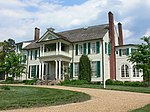Falmouth Historic District
Buildings and structures in Stafford County, VirginiaFederal architecture in VirginiaHistoric districts in Northern VirginiaHistoric districts on the National Register of Historic Places in VirginiaNRHP infobox with nocat ... and 4 more
National Register of Historic Places in Stafford County, VirginiaNorthern Virginia Registered Historic Place stubsStafford County, Virginia geography stubsUse mdy dates from August 2023

Falmouth Historic District is a national historic district located at Falmouth, Stafford County, Virginia. The district includes 29 contributing buildings in the historic core of the town of Falmouth. Notable buildings include Basil Gordon Warehouse, Customs House, the Double House, Highway Assembly of God Church, old Post Office, Calvary Pentecostal Tabernacle, the Tavern, Tavern Keeper's House, Union Methodist Church, Master Hobby School, and the Counting House. Located in the district are the separately listed Gari Melchers Home, Carlton, Clearview and Conway House.It was listed on the National Register of Historic Places in 1970.
Excerpt from the Wikipedia article Falmouth Historic District (License: CC BY-SA 3.0, Authors, Images).Falmouth Historic District
Carter Street,
Geographical coordinates (GPS) Address Nearby Places Show on map
Geographical coordinates (GPS)
| Latitude | Longitude |
|---|---|
| N 38.323888888889 ° | E -77.466388888889 ° |
Address
Carter Street
Carter Street
22402
Virginia, United States
Open on Google Maps










